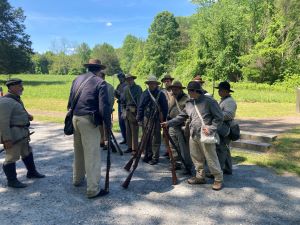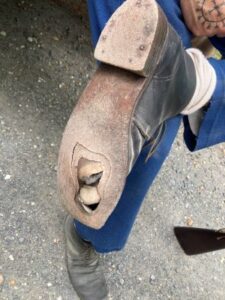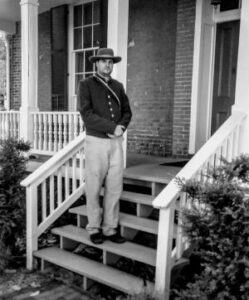While some might say it is a strange way of spending a celebratory weekend, for me it was an amazing firsthand glimpse into Civil War history through the eyes of the reenactors.
Even more than that, it was an opportunity to be present for a reenactment of one of the most successful Confederate victories, though also one of the bloodiest battles of the war that changed the nation.
Because of the thoughtfulness of one historian, and the generosity and willingness to share the love and pride in their Virginia ancestors of a dozen other men, the reencators, all incredibly knowledgeable and determined, I literally got to experience seven of the 12 miles of General Stonewall Jackson’s Flank March of 1863.
Even better, while these men in their Civil War uniforms marched the seven miles through the Wilderness, their Southern gentility enabled me to cover the route with them in one of the two safety equipment trucks that always escorts them in reenactments such as this.
It was the Third unit of the Army of the Potomac under General Fighting Joe Hooker who had crossed the Rappahannock River, and headed into this battle, a battle which also marked the only time Hooker had been commander. General Robert E. Lee, a brilliant statistician and West Point graduate second in his class and later Superintendent, had General Stonewall Jackson and his troops attack the North in the Wilderness in Jackson’s Flank March wonderfully followed and mapped by the National Park Service.
The reenactors who so generously permitted me to ride along for their march over dirt roads, through lush forests and open fields, got together at the Chancellorsville Visitor Center on federal trust lands to begin the seven-mile march organized by Daniel Myers, a railroad conductor by profession and a reenactor for seven years, coming from Carolina County for this particular Flank March.
He does it, he explains calmly and sincerely, because “15 of my ancestors wore grey,” one of them was wounded and two more died. “Every citizen has to sacrifice,” he explained, then thought deeply for a moment before adding, “and those who start wars have to fight them.”
Sgt. Myers 12th Virginia Company B was on the Flank March along with Company C. One of the reasons it was held on this particular date was to also honor the memory of General Micah Jenkins, the officer who was at Gen.Jackson’s side when both were hit by gunshot, in the darkness of night; Jackson lost his arm that night, and died from his wounds days later, but Jenkins, a graduate of the South Carolina Military Academy, now the Citadel in Charleston, SC, and first in his class, was killed May 6, 1863.
The 12th Virginia Regiment was comprised of men primarily from the Petersburg area, though some came from other areas of southeastern Virginia. They fought with the Army of Northern Virginia after being organized shortly after the 1861 start of the War and participated in numerous conflicts including the Wilderness; they were involved in the months long Siege of Petersburg and the conclusion of the Appomattox Campaign, the final days of the war before General Lee surrendered to Grant at the Appomattox Court House in April 1865.
The reenactment also included men from Company H of the 44th and Company I of the 47th Virginia Regiment .Like each of the men on the reenactment march, there is no anger over the war, more a remembrance of what their ancestors….and so many of these men know so much about their Civil War ancestry…. believed, fought for, and accepted. Several explained to me that the war was not necessarily fought over slavery; for some of the soldiers and their families fought to preserve the Union, others because their homes were burned or their families were in danger; some fought because their brothers, their fathers, their sons or their cousins were in it and they felt an obligation to be beside them as well.
If there is any one lesson, I learned from each of these very intense, dedicated, and Civil War schooled reenactors, it is their pride in their ancestry, the importance they each place on protecting the history of those who plowed the fields, hunted the lands or built the homes where they live and enjoy life today. They have a distinct purpose in reenacting those battles, skirmishes, marches, and other phases of the Civil war….it is to learn more, know more, and therefore appreciate more about what the 19th century men and their families went through. They have learned how they fought, how they marched, the equipment they used, the skills they had and the importance they placed on protecting their homeland and continuing their pride in their ancestry.

Last week’s march, more than half of the Flank March’s 12 miles, included two rest stops, both done in military style, with the men properly stacking their rifles and resting while Sgt Myers continued with more statistics and information on what was going on in May of 1863. The march took approximately two and a half hours, including two rest stops., and a final discussion of the day’s events before most got together for a late lunch. Many also headed to another location to see another group of Civil War reenactors celebrating another phase of Civil War history complete with the women in 18th century dress, the men in uniforms of varying companies. At that event, tents were lined up orderly for the overnight stay and other tents were set up out on the outskirts selling a variety of uniforms, hats and campaign memorabilia in a festive and social afternoon of American history.

That the Civil War long before their own time has impacted these men of the 21st century is not only understandable but admirable in their dedication to remembering a war that tore apart a country family by family. Their ancestors were indeed an intricate part of it…there were 108 different battles fought in Petersburg alone over a period of nine months; these men want to remember all the sacrifices of the war and want to pass on that history to their children and grandchildren so all will always remember how the nation founded just short of 100 years before survived disagreements and hostilities and moved forward.
As one of the younger participants in the 2023 Flank March explained when asked why he took a day to join with the others for the march said he was with the reenactors for a lecture on Petersburg some time ago and found it interesting. “So now I’m back,”: he said, “because I get to walk through history.”
For me, it was all of that and more. It was time to learn more from some of the reenactors on the march I accompanied, including Capt. Bill Russell, Shawn Johnson, Rick Miller and Jackson Canady from the 47th regiment, Scott Ratliff from the 44th, and Sgt. Myers and his men from the 12th Regiment, Chris Dobrilovic-Holt, Joseph Williams, Levi Dunnington, Ben Barrett, Jimmy Fowler, Sam Watkins, Jody Maury, and the man that made it possible for me to be along for all the event, Randy Watkins, a walking encyclopedia when it comes to the Civil War.

Sgt Co B
12th Virginia Infantry
But that’s another story about the next day when he escorted and taught me through more 18th century history in Virginia.
